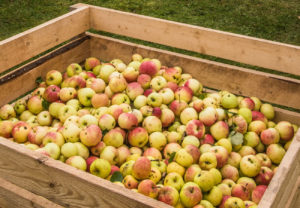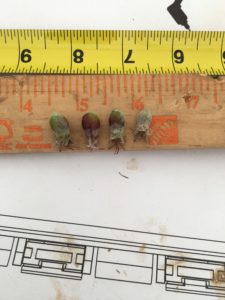Hard Cider Apples
 With the (hard) cider market growing so rapidly in North America over the last 7 or 8 years, if you’ve made it all the way to this page, you’ve probably heard a fair amount already about the unique character of true cider apples. If so, apologies; still, the story is worth repeating.
With the (hard) cider market growing so rapidly in North America over the last 7 or 8 years, if you’ve made it all the way to this page, you’ve probably heard a fair amount already about the unique character of true cider apples. If so, apologies; still, the story is worth repeating.
People in the apple world generally divide apples into three categories by usage: dessert (apples best for eating fresh), culinary (best for cooking), and cider (usually unpleasant to eat fresh, but best for fermenting into alcoholic cider).
Cider apples are further divided into four subcategories: sweet (obvious enough), bittersweet (likewise), sharp (high acidity), and bittersharp (high acidity and bitterness). Without delving too deeply into the finer aspects of these flavor components, suffice it to say that “cider apples” generally contain much more in-your-face amounts of mouth-puckering tannin, bitterness, and acid than other eating or cooking apples do.
They also often have perfumes and aromas that stand out, and are enhanced by fermentation. Even sweet cider apples, like Sweet Alford or Sweet Coppin, which don’t boast as much bitterness as many other cider varieties, have noticeable bitter elements and bouquets typically not found in fresh eating apples. Try juicing and fermenting Sweet Coppin and comparing that to a fermented dessert apples juice like Golden Delicious or Granny Smith. You be the judge.
By way of analogy, table grapes like Concord typically cannot make the most full-bodied, perfumed wines, or ones with a “lingering finish”. Similarly, the body, flavor components and aromas available from cider apples, when fermented, far outstrip those available from all but a few dessert apples.
A ripe Bulmers Norman apple can have strong, mouth-filling hints of mango and pineapple on top of noticeable but pleasant bitterness. Vilberie hits you first with almost cinnamon-like sugar spice and then knocks you over with its astringency – like a fire hydrant mouthful of wet tea leaves. It can do amazing things in a blend, but can likewise be overpowering in isolation. Golden Russet, when ripe, reminds you of lemon-zest honey. Kermerrien has an almost creamy texture.
 Cider makers typically use a blend of apples, often including dessert apples, to achieve a certain desired flavor: sweets for sugar content; bittersweets for body, mouth-feel and finish; sharps for refreshing acidity, and perhaps bittersharps for finer aromatic notes. Unlike wine grapes, only rarely can a single variety of cider apple make a stand-alone cider that is well balanced, pleasing and full-bodied. Kingston Black is often mentioned in this regard as a “vintage” quality cider apple. Single varietals are emerging, however, and as orchardists become for familiar and capable with cider apple varieties and fruit quality improves, this may be a trend to watch.
Cider makers typically use a blend of apples, often including dessert apples, to achieve a certain desired flavor: sweets for sugar content; bittersweets for body, mouth-feel and finish; sharps for refreshing acidity, and perhaps bittersharps for finer aromatic notes. Unlike wine grapes, only rarely can a single variety of cider apple make a stand-alone cider that is well balanced, pleasing and full-bodied. Kingston Black is often mentioned in this regard as a “vintage” quality cider apple. Single varietals are emerging, however, and as orchardists become for familiar and capable with cider apple varieties and fruit quality improves, this may be a trend to watch.
Stinky cider?
What about the off-flavors, such as medicinal iodine and “barnyard funk” sometimes found in ciders made exclusively with cider apples? Aren’t those unpleasant? Aren’t they the reason many North Americans remain ambivalent about traditional cider?
Yes..maybe…but, two points are worth mentioning here. First, often those are flavors or sensations that consumers come to love over many years of drinking cider. Taking wine as a reference, the pepper spice and leather of some red Rhone wines or the “roadkill” fleshy notes of certain red Burgundies are two examples of aromas that “newcomers” to wine typically don’t enjoy but learn to love, even crave, in due course. Many a British cider drinker likewise craves barnyard funk, suggesting that something more than unpleasant tastes are at work.
Second, there are so many ciders made with cider apples that do not “suffer” from off-putting funky or medicinal notes that a newcomer to hard cider made with true cider fruit (rather than dessert apples doctored up with other fruit juices or flavor additives) has plenty of choices. Try some. Then try some more. We suspect you’ll soon figure out what all the noise is about.
